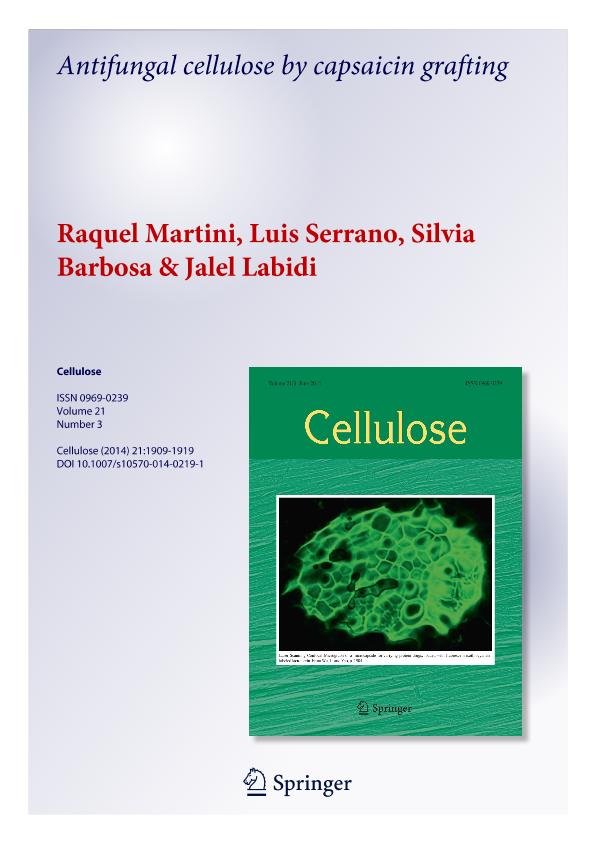Mostrar el registro sencillo del ítem
dc.contributor.author
Martini, Raquel Evangelina

dc.contributor.author
Serrano, Luis

dc.contributor.author
Barbosa, Silvia Elena

dc.contributor.author
Labidi, Jalel
dc.date.available
2017-07-31T22:21:34Z
dc.date.issued
2014-05
dc.identifier.citation
Martini, Raquel Evangelina; Serrano, Luis; Barbosa, Silvia Elena; Labidi, Jalel; Antifungal cellulose by capsaicin surface grafting; Springer; Cellulose; 21; 3; 5-2014; 1909-1919
dc.identifier.issn
0969-0239
dc.identifier.uri
http://hdl.handle.net/11336/21689
dc.description.abstract
Cellulose is one of the most abundant materials in nature. Besides its biological function, cellulose can be extracted from the cell wall and used in several industrial applications. Thus, it can be used in papers, pharmaceuticals, food, cosmetics and innovative materials such as nanocomposites, packaging, coatings and dispersion technology. With the aim of extending cellulose applications and producing so-called “smart” materials, new functionality can be introduced by physical or chemical modifications. Taking into account that capsaicin, the active component of chili peppers, is an excellent antifungal agent, a potential new material could be obtained by chemical reaction between this active compound and cellulose. In this work, capsaicin grafting onto cellulose using polycarboxylic acid as linking agent is proposed. The reaction occurrence was corroborated by Fourier transform infrared spectroscopy and UV–Vis spectrophotometry in reflectance mode. Modified cellulose with <2 wt% of capsaicin shows a strong change in antifungal activity with respect to the unmodified one. This activity was evaluated by the fungal growth inhibition test with two different fungi, Trametes versicolor and Gloeophyllum trabeum. Modified cellulose samples showed a high percentage of fungal growth inhibition, demonstrating the success of the cellulose modification and high antifungal power of the grafting molecule.
dc.format
application/pdf
dc.language.iso
eng
dc.publisher
Springer

dc.rights
info:eu-repo/semantics/openAccess
dc.rights.uri
https://creativecommons.org/licenses/by-nc-sa/2.5/ar/
dc.subject
Cellulose
dc.subject
Grafting
dc.subject
Capsaicin
dc.subject
Antifungal Activity
dc.subject.classification
Ingeniería de Procesos Químicos

dc.subject.classification
Ingeniería Química

dc.subject.classification
INGENIERÍAS Y TECNOLOGÍAS

dc.title
Antifungal cellulose by capsaicin surface grafting
dc.type
info:eu-repo/semantics/article
dc.type
info:ar-repo/semantics/artículo
dc.type
info:eu-repo/semantics/publishedVersion
dc.date.updated
2017-07-31T21:43:10Z
dc.identifier.eissn
1572-882X
dc.journal.volume
21
dc.journal.number
3
dc.journal.pagination
1909-1919
dc.journal.pais
Países Bajos

dc.journal.ciudad
Dordrecht
dc.description.fil
Fil: Martini, Raquel Evangelina. Consejo Nacional de Investigaciones Científicas y Técnicas. Centro Científico Tecnológico Bahia Blanca. Planta Piloto de Ingeniería Química (I). Grupo Vinculado al Plapiqui - Investigación y Desarrollo en Tecnología Química; Argentina. Universidad Nacional de Córdoba. Facultad de Ciencias Exactas, Físicas y Naturales; Argentina
dc.description.fil
Fil: Serrano, Luis. Universidad del País Vasco; España
dc.description.fil
Fil: Barbosa, Silvia Elena. Consejo Nacional de Investigaciones Científicas y Técnicas. Centro Científico Tecnológico Conicet - Bahía Blanca. Planta Piloto de Ingeniería Química. Universidad Nacional del Sur. Planta Piloto de Ingeniería Química; Argentina
dc.description.fil
Fil: Labidi, Jalel. Universidad del País Vasco; España
dc.journal.title
Cellulose

dc.relation.alternativeid
info:eu-repo/semantics/altIdentifier/url/http://link.springer.com/article/10.1007/s10570-014-0219-1
dc.relation.alternativeid
info:eu-repo/semantics/altIdentifier/doi/http://dx.doi.org/10.1007/s10570-014-0219-1
Archivos asociados
